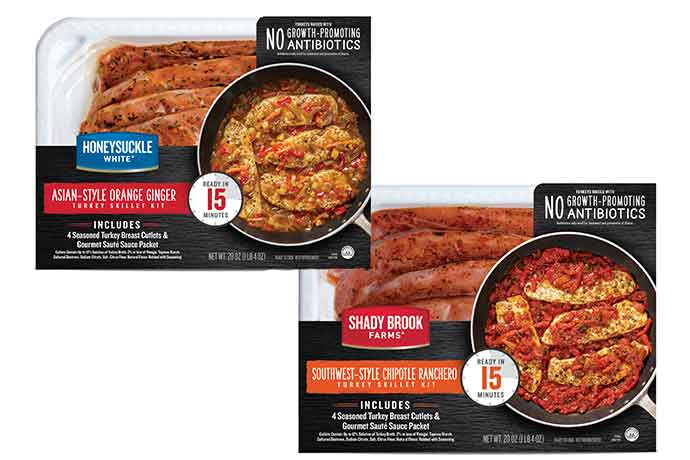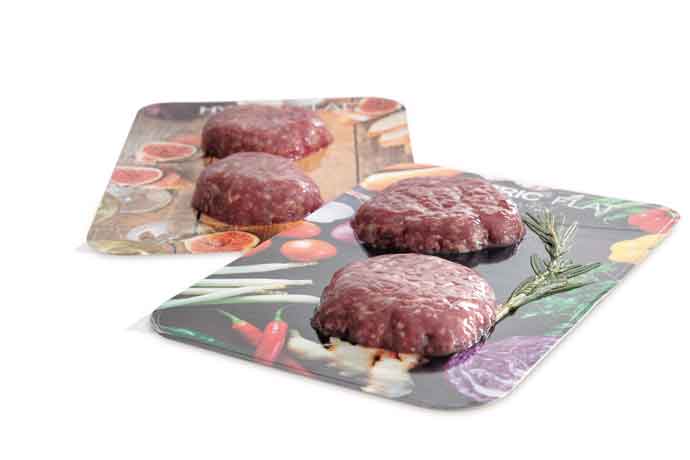Vacuum skin packaging is often referred to as “second skin” because of the tight seal that’s achieved from the film draped over the product.
When it comes to enticing consumers and meeting their parallel interests in attractive presentation, extended shelf life, product protection, reduced packaging and quality, processors have some skin in the game.
Vacuum skin packaging (VSP), often described as “second skin” because of the tight nature of the form and seal achieved when a top layer of film is heated and draped over the product, is gaining in both use and acceptance. Skin packaging is used for a variety of proteins, including bone-in and boneless cuts and fresh and pre-seasoned/pre-marinated portions. Premium products are often showcased in skin packaging.
VSP is part of a general wave of case-ready packaging that has been transforming the retail meat case over the past several years. Toronto-based Technavio projects fresh meat packaging to grow at an annual compound growth rate of 3 percent and fresh poultry packaging at an annual compound growth rate of 6 percent through 2022.
There are several advantages to this particular format. “The near-invisible film is tight and wrinkle free against the product but secures the product in place without any tension, meaning juices are not squeezed out for a better tasting product. Also because of the gentle process, sliced products do not stick together and bone-in product will not puncture the film,” explains Christian Uebele, engineering manager and product market manager, thermoformers for Multivac Inc., Kansas City, Missouri, which offers several different thermoforming and tray sealing machines that can package VSP.
Look here

This type of package may cause consumers to do a double take at the point of sale, based on how fresh and premium the product looks. “Depending on what is inside the package, the resulting presentation can look absolutely stunning and provides the consumer with the impression of a high-quality product when compared to standard packaging,” Uebele says. To achieve that look, he adds, the product is typically placed on a rigid lower web to support the product for presentation.
The billboard effect and package security are especially important in pre-marinated and pre-seasoned products, which continue to gain popularity for their flavor and convenience. “Meats with dry seasoning or light marinade can look beautiful on a flat or shallow pocket. Wet, marinated or products which do not hold their shape would benefit from a pocket to contain the product while still providing a package with the impression of high quality,” Uebele says.
Sean Brady, new business development manager for Charlotte, North Carolina-based Sealed Air Corp. – which first introduced its Cryovac Darfresh vacuum skin packaging in 1989 -- affirms the attractiveness of a skin package that also extends shelf life. “The package holds in moisture and helps marinate the product. From a consumer perspective, it has tremendous benefits in quality and appearance,” he says.
There can be challenges when using this format for some marinated and seasoned fresh products. “Depending on the amount of marinade or dry rub, you want to be sure that the liquid doesn’t evaporate or come out,” Brady notes. To prevent issues, Sealed Air’s experts like Brady work closely with processors to check the viscosity and amount of the marinade, as well as the type and shape of the tray to be used with meat packaged in a skin format.
A growing number of brands have turned to VSP for protein products, including marinated and seasoned items. For example, Maple Leaf Farms, Leesburg, Indiana, has used skin packaging for the past few years for its fresh products, including boneless duck breast, in marinades like Honey Orange, Southwest Style and Roasted Garlic flavors.
More recently, Cargill, with a protein business headquartered in Wichita, Kansas, chose VSP for its new Turkey Skillet Kits from the company’s Honeysuckle White and Shady Brook Farms brands. The kits contain four seasoned turkey breast cutlets co-packaged with a gourmet sauce packet, which include Tuscan-Style Tomato Garlic Basil, Southwest Style Chipotle Ranchero, Asian Style Orange Ginger and Thai Style Coconut Curry varieties.
The flavor delivery, eye appeal, shelf life and convenience are expected to help these products stand out in the case when they are rolled out in spring 2020. “The introduction of Honeysuckle White and Shady Brook Farms Turkey Skillet Kits reflects Cargill’s commitment to innovation that turns data-driven insights into informed product development decisions that take advantage of flavor trends and consumer behaviors,” remarks Chuck Gitkin, chief marketing officer, Cargill Protein, North America.
According to Brady, such products paired with sauce packets or other extras are catching on, along with a growing range of marinades. “When you go to Europe and see skin packaging, they’ve been doing things like marinated items and add-ons like garlic packs for a long time. Here, it’s been more of the protein by itself (in a skin pack) until the last three to five years, when we saw fish venture off into more value-added,” he says, noting that chicken and red meat have followed suit with more seasonings, marinades and add-on sauces.
Meanwhile, other suppliers have developed VSP solutions for value-added proteins. Sealpac, based in the Netherlands, offers a high-transparent barrier skin film, TraySkin, that prevents drip loss and holds marinated products, like barbecue wings or even whole seasoned birds, in place for a neater appearance. Sealpac also offers double sealing for extras; the product is skinned and the tray is hermetically sealed to create additional head room for optional extras.
Less is more

The recent marketplace push toward more sustainable packaging solutions, including packaging with less or recyclable material, is also fueling VSP applications in the meat, poultry and seafood arena. “The bottom portion of the package can be a traditional shallow pocket or presented on paperboard for an increased perception of environmental sustainability,” Uebele says of Mulivac’s VSP applications. End users can separate the cardboard backing from the plastic barrier layer and put it into paper recycling.
Likewise, Ulma Packaging, with US offices in Taunton, Massachusetts, has responded to growing interest in sustainability with its LeafSkin packaging that reduces plastic by up to 80 percent. The film is paired with a 100 percent recyclable flat cardboard tray, and the different materials are fully separable. An easy-open corner allows consumers to remove the lid, while a “recycling corner” separates the material from the tray and makes the recycling process easier.
Advanta, with a US office in Vienna, Virginia, offers a unique skin package aluminum poultry tray and film combination. Users peel back the plastic skin around the poultry and put the foil tray with the whole chicken already inside directly into the oven. They can then serve the chicken from that tray and recycle the aluminum when finished. “Both consumer demand for convenience and retailers’ requirements for longer shelf lives have refocused the priorities of poultry food packaging,” says Miguel Campos, export sales manager.


